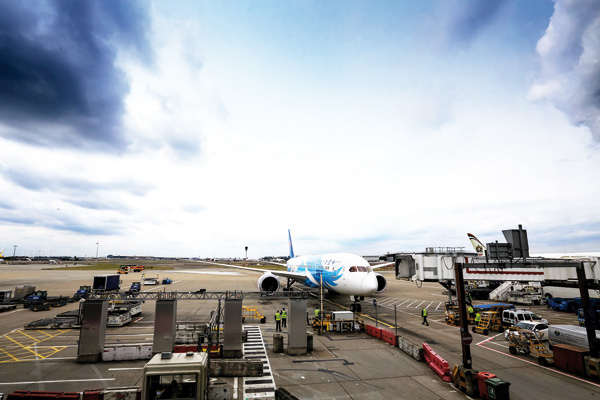Chinese airlines in it for the long haul
Updated: 2014-01-13 02:33
By TODD BALAZOVIC (China Daily)
|
||||||||
Carriers attract bigger share of China's travel boom at home and abroad
|
 |
|
China Southern Airline's Boeing Dreamliner arrives at London's Heathrow Airport from Guangzhou on Sept 10 on its maiden flight. Last year, China's big three air carriers — Air China, China Southern and China Eastern — saw a 20 percent growth in the number of international passengers. Xie Songxin / China Daily |
With the nation's outbound travel set to soar, Chinese airlines are banking on brand recognition to capitalize on the population's increasing appetite to work and travel abroad. As incomes enjoy steady growth, so too do foreign destinations hosting Chinese tourists.
China had the highest number of outbound tourists and amount of overseas spending in the world last year, according to a recent report released by the Tourist Research Center of the Chinese Academy of Social Sciences.
Ninety-seven million Chinese traveled abroad in 2013, beating the 2012 mark by roughly 14 million, according to the China National Tourism Administration. The number is expected to exceed 100 million this year.
The report said that China's tourists have had the world's strongest purchasing power since 2012. They overtook German and US tourists as the world's biggest-spending travelers in 2012, spending $102 billion overseas, a 40-percent increase from 2011.
Last year, international traffic for China's three big carriers — Air China, China Eastern and China Southern — saw the number of international passengers increase by an average of 20 percent.
To meet demand, Hainan Airlines announced it will start a new nonstop service from Beijing to Boston, Massachusetts, in June.
"Business, leisure and educational travel and trade between the United States and China have been growing dramatically," Liang Pubin, managing director of Hainan Airlines in North America, said at the time of the announcement. "This wonderful new link will stimulate this growth via the important Boston gateway."
The new flight offers access for US visitors to more than 32 Chinese cities via Hainan Airlines' hub in Beijing.
For Boston, it means adding to the 21 million annual tourists to the city — with Chinese the fastest-growing demographic in visitors — as well as bringing business travelers to stimulate the local economy.
Last year, 1.7 million Chinese traveled to the US, an increase of 40 percent on 2012, according to figures from the US Department of State.
The surge in growth of Chinese going to the US is attributed to the US easing its visa policy in 2012 to entice more foreign tourists.
"Boston is the sixth-largest airline passenger market in the US to China and the largest without a nonstop service," says Richard Davey, secretary and chief executive of the Massachusetts Department of Transportation.
"This new route will help the regional economy, boost tourism and provide a convenient connection for tens of thousands of visitors.''
Early last year, Air China, the country's largest airline, was the first Chinese carrier to run direct flights to Geneva from Beijing. It also launched a new Chengdu-Frankfurt service.
As the UK market becomes increasingly important, China Southern Airlines opened its Guangzhou-London route in June 2012, at the time operating three flights a week. This later increased to five flights a week and, in September, started to operate with its new Boeing 787 aircraft.
While domestic travel figures continue to rise, price wars among airlines and the roll-out of the country's high-speed rail network mean companies operate on thin profits to stay competitive.
Furthering competition, the Chinese government has gradually eased regulations on the aviation industry, lifting a six-year ban on the establishment of independent air carriers and giving the green light to two new privately owned airlines.
But even as they seek greener pastures, their relatively late entry into the international travel arena has made it an uphill battle for Chinese airlines, says Andrew Herdman, director-general of the Association of Asia-Pacific Airlines.
"Chinese airlines do face competitive disadvantages when they go international — in terms of product, perception, brand awareness, distribution, capability and so on," he says.
"With the growth of incomes in China and the fact that we now have a lot of outbound travel, that plays to the strength of the Chinese airlines because they are brands that are well known to Chinese travelers.
"But historically, long-haul flights to China were inbound-focused and the market source was the EU and America, so the Chinese airlines have had a disadvantage in terms of brand awareness and distribution presence in those source markets."
The increasingly refined tastes of travelers from the Chinese mainland also add to the potential success of new long-haul routes operated by China's airlines.
While global alliance partnerships have ensured that the airlines operate to international standards, most well-to-do Chinese vacationers still opt to go with international brands because they are perceived as more luxurious, says Herdman.
"Sophisticated mainland customers are quite savvy about which brands they choose, as you can tell by the kind of cars they buy and the type of luxury goods they buy," he says.
"When it comes to which hotels they stay in and which airlines they favor, they are well aware they have a choice.
"It puts pressure on the mainland carriers to up their game in terms of product and service internationally."
Regardless of factors at play, enterprising mainland airlines are making headway in the US.
According to a survey by PricewaterhouseCoopers, US airlines last year operated 53 percent of the routes between the US and China, a drop of nearly 7 percent from the year before.
Chinese airlines were responsible for the remaining 47 percent.
Most Viewed
Editor's Picks

|

|

|

|

|

|
Today's Top News
White House responds to Kimmel petition
Iran nuclear deal to take effect on Jan 20
Sharp fall in tourism hits Beijing
Ground control to Major Tang
Ready for take-off?
Sharon's death triggers mixed reactions
Former Israeli PM Ariel Sharon dead at 85
US retailers report cyber attacks
US Weekly

|

|














